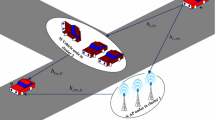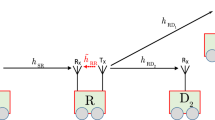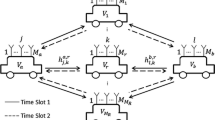Abstract
Vehicular ad hoc networks (VANETs) are able to facilitate data exchange among vehicles and provide diverse data services. The benefits of cooperative communications are such as to make it a proper idea to improve the achievable rate and diversity in VANETs. We investigate a dual-hop relay vehicular network with different transmit powers in vehicles on non-uniform shadowed double Nakagami-m fading channels in the presence of non-uniform co-channel interferers. In this paper, we investigate the diversity-multiplexing tradeoff (DMT) in such a network for three different schemes, namely, dynamic decode and forward (DDF), dynamic quantize map and forward and static quantize map and forward and prove that the DDF strategy has the optimal DMT. Also, the optimal listening and transmitting time of vehicles in various strategies as a function of the channel conditions in vehicles are determined. Finally, we extend our results to a general multi-hop relay vehicular network model with multiple half-duplex relay terminals and different average SNRs over links.










Similar content being viewed by others
Explore related subjects
Discover the latest articles and news from researchers in related subjects, suggested using machine learning.References
Jaya Suma, G., & Lalitha, R. V. S. (2016). Vehicular ad hoc networks: A hybrid approach to data dissemination in exigency situations. Wireless Networks, 22(5), 1725–1737.
Laneman, J. N., Tse, D. N. C., & Wornell, G. W. (2004). Cooperative diversity in wireless networks: Efficient protocols and outage behavior. IEEE Transactions on Information Theory, 35(12), 3062–3080.
Kim, S. (2019). Effective crowdsensing and routing algorithms for next generation vehicular networks. Wireless Networks, 25(4), 1815–1827.
Jamil, F., Javaid, A., & Umer, T. (2016). A comprehensive survey of network coding in vehicular ad-hoc networks. Wireless Networks, 23(8), 2395–2414.
Abouei, J., Bagheri, H., & Khandani, A. K. (2009). An efficient adaptive distributed space-time coding scheme for cooperative relaying. IEEE Transactions on Wireless Communications, 8(10), 4957–4962.
Gharan, S. O., Bayesteh, A., & Khandani, A. K. (2011). Asymptotic analysis of amplify and forward relaying in a parallel MIMO relay network. IEEE Transactions on Information Theory, 57(4), 2070–2082.
Bolcskei, H., Nabar, R. U., Oyman, O., & Paulraj, A. J. (2006). Capacity scaling laws in MIMO relay networks. IEEE Transactions on Wireless Communications, 5(6), 1433–1444.
Azarian, K., El Gamal, H., & Schniter, P. (2005). On the achievable diversity-multiplexing tradeoff in half-duplex cooperative channels. IEEE Transactions on Information Theory, 51(12), 4152–4172.
Yang, S., & Belfiore, J.-C. (2007). Optimal space-time codes for the MIMO amplify-and-forward cooperative channel. IEEE Transactions on Information Theory, 53(2), 647–663.
Kim, T., & Skoglund, M. (2010). On the DMT-optimality of non dynamic DF relaying in asymmetric Nakagami fading channels. IEEE Transactions on Information Theory, 56(7), 3304–3309.
Bithas, P. S., Efthymoglou, G. P., & Kanatas, A. G. (2018). V2V cooperative relaying communications under interference and outdated CSI. IEEE Transactions on Vehicular Technology, 67(4), 3466–3480.
Fu, H., Roy, S., & Cheng, J. (2018). Applying Hankel’s expansion for performance analysis in double-Nakagami (generalized-K) fading channels. IEEE Transactions on Communications, 66(10), 4893–4906.
Gong, F., Ge, J., & Zhang, N. (2010). SER analysis of the mobile-relay-based M2M communication over double Nakagami-m fading channels. IEEE. Communications Letters, 15(1), 34–36.
Kolte, R., Ozgur, A., & Diggavi, S. (2015). When are dynamic relaying strategies necessary in half-duplex wireless networks? IEEE Transactions on Information Theory, 61(4), 1720–1738.
Azarian, K., El Gamal, H., & Schniter, P. (2005). On the achievable diversity multiplexing tradeoff in half-duplex cooperative channels. IEEE Transactions on Information Theory, 51(12), 4152–4172.
Parvaresh, F., & Soltanizadeh, H. (2017). Diversity-multiplexing tradeoff of half-duplex single relay networks. IEEE Transactions on Information Theory, 63(9), 1703–1720.
Soltanizadeh, H., & Parvaresh, F., & Saberali, S. M., (2016). Computing diversity-multiplexing tradeoff of static QMF communication strategy in half-duplex diamond relay channels. In Proceedings of the IEEE international symposium information and telecommunications (pp. 1–6).
Su, Y., & Li, Y. (2013). Optimal diversity-multiplexing tradeoff of MIMO multi-way relay channel. ETRI Journal, 35(5), 919–922.
Zheng, L., & Tse, D. N. C. (2003). Diversity and multiplexing: A fundamental tradeoff in multiple-antenna channels. IEEE Transactions on Information Theory, 49(5), 1073–1096.
Yuksel, M., & Erkip, E. (2007). Multi-antenna cooperative wireless systems: A diversity-multiplexing tradeoff perspective. IEEE Transactions on Information Theory, 53(10), 3371–3393.
Gunduz, D., Khojastepour, M. A., Goldsmith, A., & Poor, H. V. (2010). Multihop MIMO relay networks: Diversity-multiplexing tradeoff analysis. IEEE Transactions on Wireless Communications, 9(5), 1738–1747.
Karmakar, S., & Varanasi, M. K. (2011). The diversity-multiplexing tradeoff of the dynamic decode-and-forward protocol on a MIMO half-duplex relay channel. IEEE Transactions on Information Theory, 57(10), 6569–6590.
Prasad, N., & Varanasi, M. K. (2010). High performance static and dynamic cooperative communication protocols for the half duplex fading relay channel. IEEE Transactions on Wireless Communications, 9(1), 1–5.
Ozgur, A., & Diggavi, S., (2012). Dynamic QMF for half-duplex relay networks. In IEEE conference international symposium on information theory (pp. 413–417).
Gunduz, D., Khojastepour, M. A., Goldsmith, A., & Poor, H. V. (2010). Multi-hop MIMO relay networks: Diversity-multiplexing tradeoff analysis. IEEE Transactions on Wireless Communications, 9(5), 1738–1747.
Avestimehr, A. S., Diggavi, S. N., & Tse, D. N. C. (2011). Wireless network information flow: A deterministic approach. IEEE Transactions on Information Theory, 57(4), 1872–1905.
Borade, S., Zheng, L., & Gallager, R. (2007). Amplify-and-forward in wireless relay networks: Rate, diversity, and network size. IEEE Transactions on Information Theory, 53(10), 3302–3318.
Gharan, O., Bayesteh, A., & Khandani, A. K. (2009). On the diversity-multiplexing tradeoff in multiple-relay network. IEEE Transactions on Information Theory, 55(12), 5423–5444.
Sreeram, K., & Birenjith, S., & Kumar, P. V., (2008). DMT of multi-hop cooperative networks—part II: half-duplex networks with full-duplex performance. In Proceedings IEEE international symposium on information theory, Toronto (pp. 6–11).
Wu, D., & Bao, L. (2013). Large-scale access scheduling in wireless mesh networks using social centrality. Journal of Parallel and Distributed Computing, 73(8), 1049–1065.
Khayatian, H., Saadat, R., & Abouei, J. (2013). Coalition-based approaches for joint power control and relay selection in cooperative networks. IEEE Transactions on Vehicular Technology, 62(2), 835–842.
Soroush, S., Abouei, J., Mirjalily, G., & Taban, M. R. (2017). A congestion efficient cooperative positioning scheme for vehicular networks. In Proceedings of the IEEE Iranian conference on electrical engineering (pp. 1713–1718).
Qin, Z., & Wu, D. (2018). Modeling and analysis of data aggregation from convergecast in mobile sensor networks for industrial IoT. IEEE Transactions on Industrial Informatics, 14(10), 4457–4467.
Gunduz, D., & Goldsmith, A., & Poor, H. V., (2008). MIMO two-way relay channel: diversity-multiplexing trade-off analysis. In Proceeding of the Asilomar conference on signals, systems, and computers, Pacific Grove, CA.
Ozgur, A., & Diggavi, S. N. (2013). Approximately achieving Gaussian relay network capacity with lattice-based QMF codes. IEEE Transactions on Information Theory, 59(12), 8275–8294.
Chelli, A., Hamdi, R., & Alouini, M.-S. (2014). Channel modeling and performance analysis of V2I communication systems in blind bend scattering environments. Progress in Electromagnetics Research, 57, 233–251.
Wei, C., & Zhiyi, H., & Tianren, Y., (2008). A street reference model of MIMO vehicle-to-vehicle fading channel. IEEE conference on industrial electronics and applications (pp. 275–278).
Mangel, T., Schweizer, F., & Kosch, T. (2011). Vehicular safety communication at intersections: Buildings, Non-line-of-sight and representative scenarios. In Conference: Wireless on-demand network systems (pp. 35–41).
Faisal, F. J., Haider, M., & Butt, A. (2017). Performance analysis of VANETs under Rayleigh, Rician, Nakagami-m and Weibull fading. In Conference international communications computer (pp. 127–132).
Krikidis, I., & Suraweera, H. A. (2012). Full duplex relaying over block fading channel: A diversity perspective. IEEE Transactions on Wireless Communications, 11(12), 4524–4535.
Prudnikov, A. P., Brychkov, Y. A., & Marichev, O. I. (1990). Integrals and series (Vol. 3). New York, NY: Gordon and Breach.
Gradshteyn, I. S., & Ryzhik, I. M. (2007). Table of integrals, series, and products (7th ed.). New York: Academic.
Author information
Authors and Affiliations
Corresponding author
Additional information
Publisher's Note
Springer Nature remains neutral with regard to jurisdictional claims in published maps and institutional affiliations.
Appendices
Appendix 1: DMT of full-duplex network
In this section, we calculate the DMT of two-hop full-duplex relay network. For a FD relay channel, if all the nodes in the network know the channel realizations \(h_{SR_1}\) and \(h_{R_1D}\), the information theoretical cut-set upper bound \(C_u(\rho ^a, \rho ^b)\) on the achievable rate of the link \(S-D\) with a constant additive gap is given by
We can find \(d_{FD}(r)\) of a full-duplex network by solving the problem:
The exponential orders of the instantaneous SNRs for \(S{-}R_1\) and \(R_1{-}D\) links are defined as
In this case, the outage event, \(C_u<r\log \rho \), at the high SNR regime is equivalent to having \(\min (\alpha ^+,\beta ^+) < r\log \rho \). Using the joint probability density function (pdf) of the random variables \((\alpha ,\beta )\) and after some simplifications in a manner similar to [27], we come up with the following optimization problem:
We can split the optimization problem (44) into three separate optimizations as follows:
Note that in the optimization problem \(S_1\) and \(0\le \beta \le b\) are the only constraints on \(\beta \) hence, the best options are \(\beta = b\), thus, we have \(S_1=m_1{(a-r)}^+\). With a similar argument as in \(S_1\) for the optimization problems \(S_2\), \(d_{FD}(r)\) of a half-duplex linear network is achieved as
and this completes the proof of the Proposition 1.
Appendix 2: DMT of DDF strategy
We calculate the DMT of a two-hop HD relay vehicular network when the relay vehicle uses the DDF protocol.
For simplicity, we assume \(\eta _1=\rho ^a\) and \(\eta _2=\rho ^b\) then, we have \(\gamma _i=\frac{\eta _i \mid h_i\mid ^2}{N_0}, i=1,2\). By using (2), the pdf of the channel power gain \(\gamma _i, i=1,2\) is obtained as
Let us express the modified Bessel function \(K_{(m_{i,2}-m_{i,1})}\left( 2\sqrt{m_{i,1}m_{i,2}\frac{x}{\eta _i}}\right) \) according to the Meijer-G function as [41],
By using the hyper-geometric function in Meijer-G function [42] and simplifying it, we have,
where \(c_{i,k}\) is as
and \((v)_n\) is the Pochhammer symbol defined in [41].
Having \(\eta _1=\rho ^a\), \(\eta _2=\rho ^b\), \(\gamma _1=\rho ^\alpha \), \(\gamma _2=\rho ^\beta \) and for the high SNR the pdf of double Nakagami-m distribution over \(S-R-D\) channel can be obtained as
We state the outage event at the destination D as the situation that any message cannot be recovered by D. Thus, the overall outage probability of the DDF protocol for high SNR at the destination is denoted as
where
where \(O_i (r,t),i=1,2\) are the outage regions of two events that are occurred in the network as in Sect. 4.1. In (52), the integral is conquered by the term with the largest SNR exponent for when the SNR tends to infinity. Therefore, by using Laplace’s principle in [19], the DMT in (8) for the HD relay can be obtained as
where \(m_1=\min (m_{1,1},m_{1,2})\), \(m_2=\min (m_{2,1},m_{2,2})\) and also we have,
This completes the proof of the DMT problem with the DDF protocol in Sect. 4.1.
Appendix 3: DMT of DQMF strategy
All rates less than \(\max _{t(h_{1},h_{2})}C(\rho ^a,\rho ^b)-K_2\) are achievable with the DQMF scheme with global CSI as in Sect. 4.2. Thus, the outage probability for the high SNR is obtained as
where \(f_{\alpha , \beta }(\alpha , \beta )\) is given in (51). By using similar steps as “Appendix 1” section, the DMT of the DQMF strategy with global CSI is obtained as
where
The optimal choice for t is achieved by \(t\alpha =(1-t)\beta \). This results in (25).
Appendix 4: DMT of SQMF strategy
In [14], it is shown that the rate achieved by SQMF where the relay vehicle listens with a fixed schedule is lower of \(C(\rho ^a,\rho ^b)-K_2\). The time of the listening and transmitting t in the SQMF strategy are selected as it can minimize the outage without the aware of instantaneous CSI. Thus, the optimal probability of outage for the high SNR regime is characterized as
where by using Laplace’s method of integration [19], the the \( d_{SQMF}(r)\) exponent is given by
Appendix 5: Proof of Corollary 1
To compute the ratio \(\zeta (r)=\frac{d_{{\mathrm {DDF}}}(r)}{d_{{\mathrm {SQMF}}}(r)}\) in a two-hop relay vehicular network with same shape parameter over links (\(m=m_1=m_2\)), we calculate the DMT of the DDF and SQMF strategies in Sect. 4 and then, we prove that \(\zeta (r) \le 2\). In this regard, we must examine two cases, then we prove that the above inequality is valid for each case.
1)For the case \(b>a\), the inequality \(\frac{d_{{\mathrm {DDF}}}(r)}{d_{{\mathrm {SQMF}}}(r)}\le 2\) is calculated as
Then, we can obtain
The above inequality is valid only if \(0<r<\frac{ab}{a+b} \ {\text {or}} \ r>\frac{-2b^2+ba}{a-3b}\) and thus (60) is true.
2)If \(a>b\). The DMT is given as \(d_{{\mathrm {DDF}}}(r)=b-\frac{ra}{a-r}\) and we can show that inequality \(\zeta (r)\le 2\) is equivalent to
then, the inequality (62) is valid only if \(0<r<\frac{ab}{a+b} \ {\text {or}} \ r>\frac{-2a^2+ba}{b-3a}\). Similar to previous cases, the DMTs ratio of the DDF and SQMF schemes is less than or equal 2 and this completes the proof of Corollary 1 in Sect. 3.
Rights and permissions
About this article
Cite this article
Khayatian, H., Parvaresh, F., Abouei, J. et al. On optimal relaying strategies for VANETs over double Nakagami-m fading channels. Wireless Netw 26, 3521–3537 (2020). https://doi.org/10.1007/s11276-020-02278-3
Published:
Issue Date:
DOI: https://doi.org/10.1007/s11276-020-02278-3




